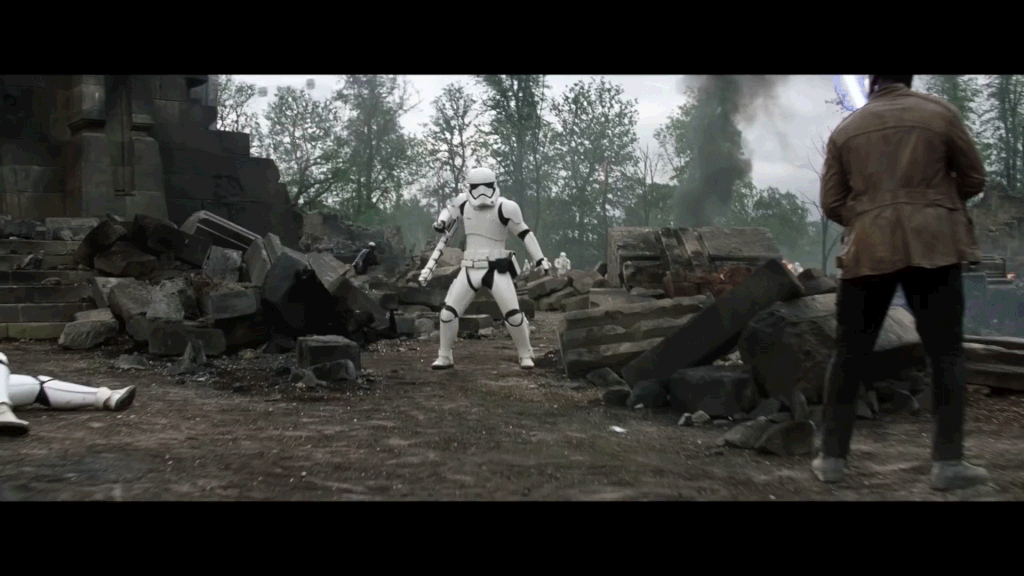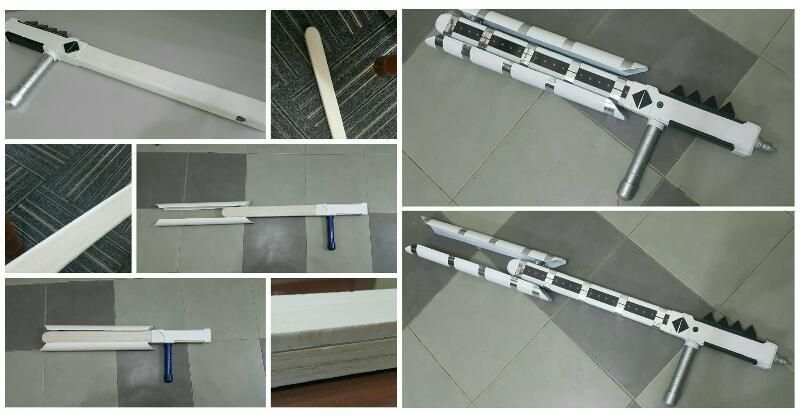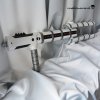You are using an out of date browser. It may not display this or other websites correctly.
You should upgrade or use an alternative browser.
You should upgrade or use an alternative browser.
The Force Awakens Stormtrooper Electrostaff
- Thread starter Pacman117
- Start date
widescreen
Well-Known Member
For the main tube you can get oval tubing, but I can only find the plastic conduit only up to 32mm wide (probably too small).
Steel tube can be bought in 40mm x 20mm & 50mm x25mm (both 1.5mm wall thickness) - more suitable IMO.
Steel tube can be bought in 40mm x 20mm & 50mm x25mm (both 1.5mm wall thickness) - more suitable IMO.
widescreen
Well-Known Member
There is anoher thread on this subject - I've put a lin on that one to thi one. hopefully we can keep all the infomation in the one thread.
http://www.therpf.com/showthread.php?t=252623&p=3867536#post3867536
http://www.therpf.com/showthread.php?t=252623&p=3867536#post3867536
TheFlatPlat
New Member
I am actually in the process of making a Baton like this right now. I wondered about the motion involved, and after watching a bad quality video a few times frame by frame, I came to the conclusion that it slides, and doesn't swivel. I could be wrong there, but i am pretty sure there are no frames that suggest the "blades" flying in a circular motion. Here is the video i used, feel free to judge for your self  https://www.youtube.com/watch?v=3BjzsQUCjtg=0m10s
https://www.youtube.com/watch?v=3BjzsQUCjtg=0m10s
Anyway, good luck with your building!
Anyway, good luck with your building!
widescreen
Well-Known Member
I'm in agreement with ARKM.
I've been working on how to get the blades/electrodes (whatever you want ot call them) to split apart & then rotate. Not as difficult as I first thought.
I'll post some pics once I've fine tuned it some more.
I've been working on how to get the blades/electrodes (whatever you want ot call them) to split apart & then rotate. Not as difficult as I first thought.
I'll post some pics once I've fine tuned it some more.
Mara Jade's Father
Master Member
FYI
http://www.darkhorizons.com/news/40716/lucasfilm-confirms-stormtrooper-tr-8r-details
http://www.darkhorizons.com/news/40716/lucasfilm-confirms-stormtrooper-tr-8r-details
Now Lucasfilm has revealed some backstory about the character. Dubbed FN-2199 (aka. 'Nines'), the character was introduced in Greg Rucka's book "Before the Awakening" and trained and served on a squad with Finn (then FN-2187) in the First Order. His weapon is called a Z6 baton and he's part of an elite squad of riot controllers
TheFlatPlat
New Member
Actually the "blades" do flip/swivel out. I downloaded the Finn TV spot from YouTube and made an animated GIF for ya in 1080p resolution. I set the delay between frames to 1 second so you can see the flip out animation. You're welcome.
http://i6.photobucket.com/albums/y237/Evil-Henchman/Various Pics/TFA_Baton.gif~original
Well. I seem to have been wrong on that point. I see now that the join does not move, and it swivels around the point. It would have been much easier to make too...That annoys me somewhat....
I think i will just go ahead with the sliding mechanism i have now, and maybe one day i will make a flip out one....
.
.
.
.
.
.
.
Did i mention that annoyed me?
Last edited:
Praetor
Active Member
Has anyone devised a reasonable/practical/simple method of making the arms pop-out and swing forward as in the film?
I've seen some simple enough strapping and spring solutions to get the flip-out action working. Without using a more compact cylinder-type solution, I don't see an issue with this. But the arms pop outward first, seemingly at the same time as they swing forward. This is the only part I've had trouble visualising a simple solution for.
I was thinking that each arm axis could have it's own strap, connecting it to the primary spring. This would allow them to swing independently and lend itself to some vertical pop-out arrangement.
Any ideas?
I've seen some simple enough strapping and spring solutions to get the flip-out action working. Without using a more compact cylinder-type solution, I don't see an issue with this. But the arms pop outward first, seemingly at the same time as they swing forward. This is the only part I've had trouble visualising a simple solution for.
I was thinking that each arm axis could have it's own strap, connecting it to the primary spring. This would allow them to swing independently and lend itself to some vertical pop-out arrangement.
Any ideas?
hobenator762
New Member
What if instead of the rods telescoping out to the sides, you have a tube inside a tube the inner has a little guide rid and the outer has a groove cut into it in a spiral so as it goes forwards it also goes out. Not sure how to incorporate it into already solid plans but it seems like a simple plan.
mellowmind
New Member
Praetor
Active Member
Hello all,
I've spotted some detailing that doesn't appear to have been picked-up elsewhere, so I'm posting here and in the other thread regarding the Z6. Let me know what you think:

...So, I'm pretty sure there are two big details here that might reveal more about how this thing works. Part A appears to be a rod of some sort, running in parallel with the main axis of the arms. It clearly sits in front of the axis-rod (Axle? Excuse my misuse of terminology!) when the arms are extended... Where it appears when folded is unclear and I can't find references to show this.
The second detail (the B parts) appears to be end-caps of a sort, which when the arms are in the folded position, would partially cover the end of the baton. These appear to be metallic to match the electrode bars/stripes.
Parts B1 and B2 would appear to be aesthetic, but it's part A1-A2 (a single rod?) that is interesting to me. If this was a spring or cable, it might be responsible for the flip-out action of the arms. If this is a rod, it might be a locking mechanism.
Let's assume it's a spring, or a pair of springs, in this configuration it would make for a really simple method of applying the rotational force required to swing-out the arms. If you imagine that in the extended configuration, the springs are at rest and the arms locked by their axis (probably internally). When folded, the springs would be stretched and twisted around the axis (partially, it only swings out 180 degrees) and would then be placed under tension and the arms would need to lock into the folded configuration.
On releasing the arms, the spring would tend towards the rest position, pulling the arms out (in a single direction, too, as is seen on film). A similar effect could be achieved if they were cabling extending into the body of the baton and held under tension internally by some loaded spring mechanism. Similarly, it could be responsible for pushing the arms outward (away from the baton body) which has been observed too (when extended, the arms are clearly seated further away from the baton body than when folded, sitting against the baton body). Either way, these add nothing aesthetically, so I'm pretty certain that they give us a clue as to the underlying mechanics of the device.
If a locking mechanism (which appears more likely, because they reflect light as a rod would) I'm not quite sure how they'd work, but may simply act as a catch against some out-of-sight rod or latch-arm that sits under the arms, extending from the axle.
What do people think?...
I've spotted some detailing that doesn't appear to have been picked-up elsewhere, so I'm posting here and in the other thread regarding the Z6. Let me know what you think:

...So, I'm pretty sure there are two big details here that might reveal more about how this thing works. Part A appears to be a rod of some sort, running in parallel with the main axis of the arms. It clearly sits in front of the axis-rod (Axle? Excuse my misuse of terminology!) when the arms are extended... Where it appears when folded is unclear and I can't find references to show this.
The second detail (the B parts) appears to be end-caps of a sort, which when the arms are in the folded position, would partially cover the end of the baton. These appear to be metallic to match the electrode bars/stripes.
Parts B1 and B2 would appear to be aesthetic, but it's part A1-A2 (a single rod?) that is interesting to me. If this was a spring or cable, it might be responsible for the flip-out action of the arms. If this is a rod, it might be a locking mechanism.
Let's assume it's a spring, or a pair of springs, in this configuration it would make for a really simple method of applying the rotational force required to swing-out the arms. If you imagine that in the extended configuration, the springs are at rest and the arms locked by their axis (probably internally). When folded, the springs would be stretched and twisted around the axis (partially, it only swings out 180 degrees) and would then be placed under tension and the arms would need to lock into the folded configuration.
On releasing the arms, the spring would tend towards the rest position, pulling the arms out (in a single direction, too, as is seen on film). A similar effect could be achieved if they were cabling extending into the body of the baton and held under tension internally by some loaded spring mechanism. Similarly, it could be responsible for pushing the arms outward (away from the baton body) which has been observed too (when extended, the arms are clearly seated further away from the baton body than when folded, sitting against the baton body). Either way, these add nothing aesthetically, so I'm pretty certain that they give us a clue as to the underlying mechanics of the device.
If a locking mechanism (which appears more likely, because they reflect light as a rod would) I'm not quite sure how they'd work, but may simply act as a catch against some out-of-sight rod or latch-arm that sits under the arms, extending from the axle.
What do people think?...
Praetor
Active Member
...Here's my quick/cr*ppy MS Paint diagram of how it would work as a locking mechanism:
View attachment 593248

Edit: Note - This does not depict the other detailing, or the arm positioning away from the body on extension/flip-out.
View attachment 593248
Edit: Note - This does not depict the other detailing, or the arm positioning away from the body on extension/flip-out.
JJ Griffin
Sr Member
renegadecow, any thoughts on Praetor's findings~?
Last edited by a moderator:
renegadecow
Active Member
Opening them by inertia works well enough for me. Plus unless more durable materials are used (in mine at least) a heavily spring loaded version will eventually beat itself to death unless the arms are made so light like vacuformed sheets. But do keep in mind that multiple batons were used in the film: a seemingly more detailed version (presumably the one that flips out or which was used to take pics with in the book) and the actual fighting version with rubbery arms.
JJ Griffin
Sr Member
Opening them by inertia works well enough for me. Plus unless more durable materials are used (in mine at least) a heavily spring loaded version will eventually beat itself to death unless the arms are made so light like vacuformed sheets. But do keep in mind that multiple batons were used in the film: a seemingly more detailed version (presumably the one that flips out or which was used to take pics with in the book) and the actual fighting version with rubbery arms.
Very true! Sorry to bother you from your hard work xD
Similar threads
- Replies
- 6
- Views
- 1,721
- Replies
- 7
- Views
- 1,114





